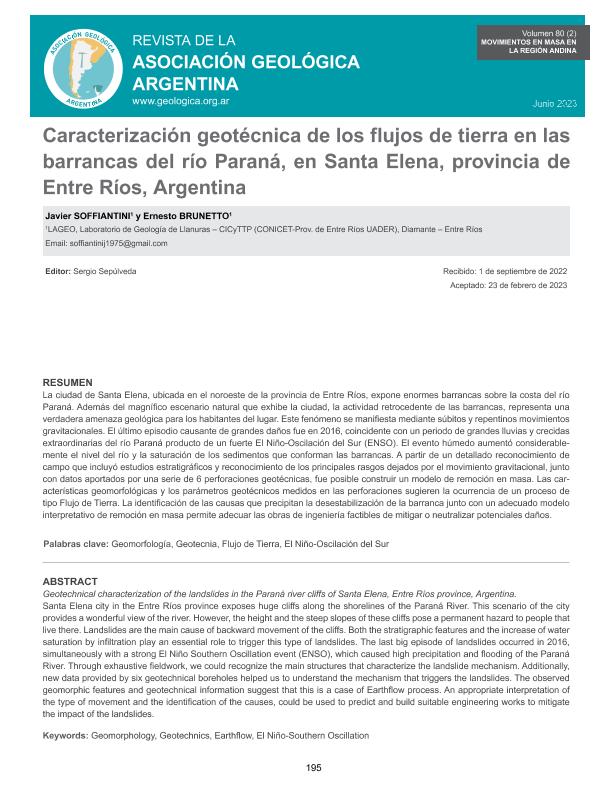Mostrar el registro sencillo del ítem
dc.contributor.author
Soffiantini, Javier

dc.contributor.author
Brunetto, Ernesto

dc.date.available
2023-12-28T19:07:25Z
dc.date.issued
2023-02
dc.identifier.citation
Soffiantini, Javier; Brunetto, Ernesto; Caracterización geotécnica de los flujos de tierra en las barrancas del río Paraná, en Santa Elena, provincia de Entre Ríos, Argentina; Asociación Geológica Argentina; Revista de la Asociación Geológica Argentina; 80; 2; 2-2023; 195-216
dc.identifier.issn
1853-7138
dc.identifier.uri
http://hdl.handle.net/11336/221864
dc.description.abstract
La ciudad de Santa Elena, ubicada en el noroeste de la provincia de Entre Ríos, expone enormes barrancas sobre la costa del río Paraná. Además del magnífico escenario natural que exhibe la ciudad, la actividad retrocedente de las barrancas, representa una verdadera amenaza geológica para los habitantes del lugar. Este fenómeno se manifiesta mediante súbitos y repentinos movimientos gravitacionales. El último episodio causante de grandes daños fue en 2016, coincidente con un periodo de grandes lluvias y crecidas extraordinarias del río Paraná producto de un fuerte Niño-Oscilación del Sur (ENSO). El evento húmedo aumentó considerablemente el nivel del río y la saturación de los sedimentos que conforman las barrancas. A partir de un detallado reconocimiento de campo que incluyó estudios estratigráficos y reconocimiento de los principales rasgos dejados por el movimiento gravitacional, junto con datos aportados por una serie de 6 perforaciones geotécnicas, fue posible construir un modelo de remoción en masa. Las características geomorfológicas y los parámetros geotécnicos medidos en las perforaciones sugieren la ocurrencia de un proceso de tipo Flujo de Tierra. La identificación de las causas que precipitan la desestabilización de la barranca junto con un adecuado modelo interpretativo de remoción en masa permite adecuar las obras de ingeniería factibles de mitigar o neutralizar potenciales daños.
dc.description.abstract
Santa Elena city in the Entre Ríos province exposes huge cliffs along the shorelines of the Paraná River. This scenario of the city provides a wonderful view of the river. However, the height and the steep slopes of these cliffs pose a permanent hazard to people that live there. Landslides are the main cause of backward movement of the cliffs. Both the stratigraphic features and the increase of water saturation by infiltration play an essential role to trigger this type of landslides. The last big episode of landslides occurred in 2016, simultaneously with a strong El Niño Southern Oscillation event (ENSO), which caused high precipitation and flooding of the Paraná River. Through exhaustive fieldwork, we could recognize the main structures that characterize the landslide mechanism. Additionally, new data provided by six geotechnical boreholes helped us to understand the mechanism that triggers the landslides. The observed geomorphic features and geotechnical information suggest that this is a case of Earthflow process. An appropriate interpretation of the type of movement and the identification of the causes, could be used to predict and build suitable engineering works to mitigate the impact of the landslides.
dc.format
application/pdf
dc.language.iso
spa
dc.publisher
Asociación Geológica Argentina

dc.rights
info:eu-repo/semantics/openAccess
dc.rights.uri
https://creativecommons.org/licenses/by-nc/2.5/ar/
dc.subject
GEOMORFOLOGÍA
dc.subject
GEOTECNIA
dc.subject
FLUJO DE TIERRA
dc.subject
EL NIÑO-OSCILACIÓN DEL SUR
dc.subject.classification
Geología

dc.subject.classification
Ciencias de la Tierra y relacionadas con el Medio Ambiente

dc.subject.classification
CIENCIAS NATURALES Y EXACTAS

dc.title
Caracterización geotécnica de los flujos de tierra en las barrancas del río Paraná, en Santa Elena, provincia de Entre Ríos, Argentina
dc.title
Geotechnical characterization of the landslides in the Paraná river cliffs of Santa Elena, Entre Ríos Province, Argentina
dc.type
info:eu-repo/semantics/article
dc.type
info:ar-repo/semantics/artículo
dc.type
info:eu-repo/semantics/publishedVersion
dc.date.updated
2023-12-18T11:35:53Z
dc.identifier.eissn
1851-8249
dc.journal.volume
80
dc.journal.number
2
dc.journal.pagination
195-216
dc.journal.pais
Argentina

dc.journal.ciudad
Ciudad Autónoma de Buenos Aires
dc.description.fil
Fil: Soffiantini, Javier. Provincia de Entre Ríos. Centro de Investigaciones Científicas y Transferencia de Tecnología a la Producción. Universidad Autónoma de Entre Ríos. Centro de Investigaciones Científicas y Transferencia de Tecnología a la Producción. Consejo Nacional de Investigaciones Científicas y Técnicas. Centro Científico Tecnológico Conicet - Santa Fe. Centro de Investigaciones Científicas y Transferencia de Tecnología a la Producción; Argentina
dc.description.fil
Fil: Brunetto, Ernesto. Provincia de Entre Ríos. Centro de Investigaciones Científicas y Transferencia de Tecnología a la Producción. Universidad Autónoma de Entre Ríos. Centro de Investigaciones Científicas y Transferencia de Tecnología a la Producción. Consejo Nacional de Investigaciones Científicas y Técnicas. Centro Científico Tecnológico Conicet - Santa Fe. Centro de Investigaciones Científicas y Transferencia de Tecnología a la Producción; Argentina
dc.journal.title
Revista de la Asociación Geológica Argentina

dc.relation.alternativeid
info:eu-repo/semantics/altIdentifier/url/https://revista.geologica.org.ar/raga/article/view/1659
Archivos asociados
